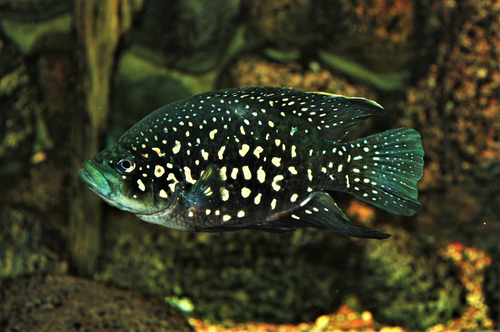There’s no reason to stress about which friend you’ll get for your duboisi cichlid. We have a list of the best duboisi cichlid tank mates all ready for you to choose from!
The best duboisi cichlid tank mates are fish that enjoy the same water hardness, water temperature, and general environment as the duboisi cichlid. That said, they also can hold their own at meal time, and they have compatible temperaments. Some examples of these are several types of African Cichlids and catfish.
In this article we’ll go over the duboisi cichlid tank mates that make the most sense for this vibrant member of the fish family. We will show you what makes each of these fish so compatible and we’ll go over the most important things about your duboisi cichlid to consider when choosing it’s neighbors. Let’s begin!
Contents
Duboisi Cichlid Tank Mates – What You Need to Know
Below, you will find everything that is necessary to know about the duboisi cichlid and what that has to do with tank mates.

Temperament
The temperament of duboisi cichlids is not necessarily easy to explain. Most aquarists settle for saying that they should be kept away from “conspecifics” due to bullying tendencies. However, the truth of the matter is, duboisi cichlids just need to be kept away from more of their own kind.
Because they can be aggressive, it is best to pair them up with tank mates who are either too big to bully, or have just as much of a nasty attitude when threatened so that they can’t be “pushed around.” Generally, other cichlids of a different type work best, such as African Cichlids.
Size
Growing to about 5 inches in length, duboisi cichlids are not the largest cichlids of the family. That being said, size is still an important consideration when it comes to finding the correct tank mates for this particular kind of fish.
After all, if you get tank mates that are too small, they can either be worried to death or simply mistaken for a source of food. If they’re much larger, the tables can turn and it is your duboisi cichlid that could be in danger!
Competition
Food competition occurs when one fish is eating a very similar diet to another fish. When this is happening, the chances that the first fish will out-swim the other fish and get more than their fair share could lead to sad consequences. To fix this, be sure your duboisi cichlid’s tank mates are eating more meat-based foods than the mainly veggie-eating duboisi cichlid.
Parameters & Tank Setup
The duboisi cichlid will feel safest in a tank that has plenty of obstacles and plant life to hide between, breaking up its eye-line. Additionally, a duboisi cichlid won’t survive well without a temperature range specifically between 72 degrees Fahrenheit and 80 degrees Fahrenheit.
Find tank mates with similar needs for the happiest fish community!
Best Duboisi Cichlid Tank Mates
1. Peacock Cichlid
2. Fontosa Cichlid
3. Red Zebra Cichlid
4. Venustus Cichild
5. Buffalo Head Cichlid
6. Electric Yellow Cichlid
7. Cuckoo Catfish
Check out these other top posts in this category:
1. Peacock Cichlid
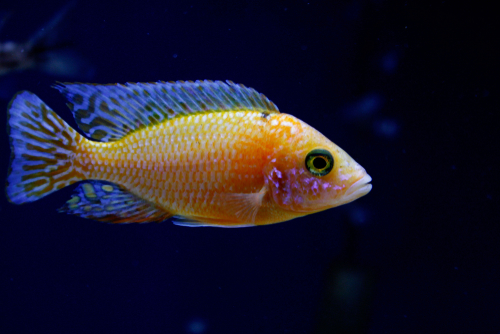
- Scientific Name: Aulunocara
- Adult Size: 4 to 6 inches
- Compatible With: Duboisi Cichlids
- Care Level: Easy
- Origin: Lake Malawi in East Africa
There are few fish that can boast as many colors and variations as the peacock cichlid. Perhaps one of the prettiest in a whole family of pretty fish is the blue peacock cichlid. These fish are definitely stunners when it comes to looks as well as attitude!
Peacock cichlids are semi-aggressive. What this means is that they will be able to stand up to the duboisi cichlid’s attitude and potential for bullying without getting too stressed about it. Of course, it helps that the peacock cichlid usually grows to be the same size, or even a bit larger, than the duboisi cichlid!
The peacock cichlid is, as previously mentioned, named for it’s good looks. It has feather-like fins, which are just as lovely and spotted as the bird of the same name. Their bodies are usually one or two colors in a subtle, marbled pattern. As long as you have enough obstacles and room in your tank, keeping a peacock with a duboisi cichlid should make for a beautiful tank!
Pros of keeping with Duboisi Cichlid:
- Can’t be bullied
- No food competition
Cons of keeping with Duboisi Cichlid :
- Some chance of aggression
2. Frontosa Cichlid
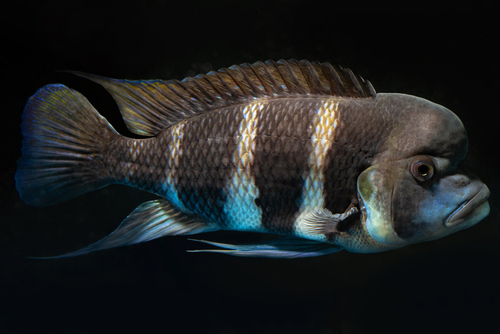
- Scientific Name: Cyphotilapia frontosa
- Adult Size: 12 to 14 inches
- Compatible With: Duboisi Cichlids
- Care Level: Medium Difficulty
- Origin: East Africa
Frontosa cichlids are another in the same family as the duboisi cichlid. They can be pretty but aggressive! They generally tend to come in shades like a thundercloud; they are blue, gray, or sometimes even white. These colors are cut across with black stripes which make them look intimidating, but nonetheless lovely.
Frontosa cichlids are semi-aggressive, and they can get much larger than the duboisi cichlid. The good news is, that usually means that the duboisi cichlid won’t be tempted to bully the frontosa. However, if you do not provide plenty of room in the tank, the tables could turn and your duboisi cichlid could find itself bullied by the frontosa! Frontosa are also on of the larger African cichlids out there so make sure your duboisi cichlids aren’t too small when you add them as a tank mate.
Pros of keeping with Duboisi Cichlid:
- Can’t be bullied
- No food competition
Cons of keeping with Duboisi Cichlid :
- Requires large tank
- Some chance of aggression
3. Red Zebra Cichlid
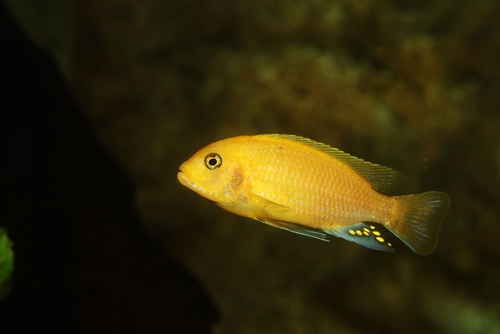
- Scientific Name: Maylandia estherae
- Adult Size: 4 to 5 inches
- Compatible With: Duboisi Cichlids
- Care Level: Easy
- Origin: Lake Malawi, East Africa
Another cichlid relative of the duboisi cichlid hailing from the same lake in East Africa is the Red Zebra Cichlid. This fish is omnivorous, meaning it is easier to please than several other cichlids, which only eat meat or mostly carnivorous foods!
The red zebra cichlid can also be just as aggressive as some of the others in it’s family, but a pleasant perk is that it will not get much bigger than the duboisi cichlid. This means that it tends to cause less infighting.
Not only is its similarity in size a great trait for a fish that will be sharing space with the duboisi cichlid, but the red zebra cichlid is also nice to look at. It is known to come in a variety of colors. Some of these are beige, blue, pink, yellow, red, brown, or a mottled pattern of all of the above!
Pros of keeping with Duboisi Cichlid:
- Can’t be bullied
- No food competition
Cons of keeping with Duboisi Cichlid :
- Some chance of aggression
4. Venustus Cichild
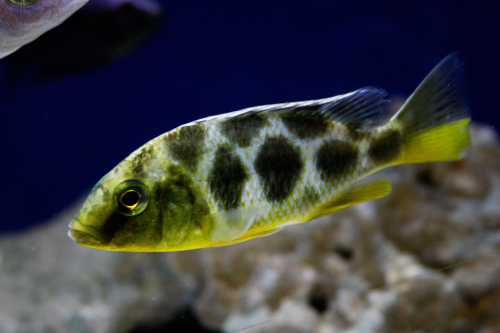
- Scientific Name: Nimbochromis venustus
- Adult Size: 12 inches
- Compatible With: Duboisi Cichlids
- Care Level: Difficult
- Origin: Shire River and Lake Malawi, East Africa
Venustus cichlids, also known as Giraffe cichlids because of their iconic spotted patterns, are gorgeous and will definitely catch the eye of anyone looking at your aquarium. At maturity, you may even see the males transform from their spotted patterns to a beautiful electric blue, which is quite the site to behold! However, they are another large African cichlid species. Although they are typically less aggressive than the frontosa, they will still need plenty of space to avoid fighting with the other fish!
Pros of keeping with Duboisi Cichlid:
- Can’t be bullied
- No food competition
Cons of keeping with Duboisi Cichlid :
- Very large fish requiring a large tank and space
5. Buffalo Head Cichlid
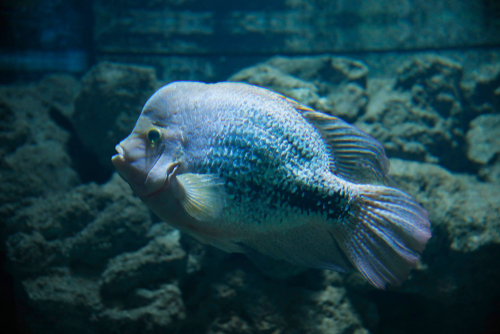
- Scientific Name: Steatocranus casuarius
- Adult Size: 3 inches
- Compatible With: Duboisi Cichlids
- Care Level: Easy
- Origin: Congo River
If you were hoping to find a fish that was unique-looking, you’ve certainly come to the right place with the buffalo head cichlid! This fish is a smaller, unique looking cichlid that can be a delightful addition to your cichlid tank.
As long as there is plenty of decor to break up the eye line of your duboisi cichlid, the buffalo head cichlid shouldn’t have too much to fear in the way of bullying. In the meantime, you can enjoy its dark coloring and incredibly prominent, almost comical forehead!
Pros of keeping with Duboisi Cichlid:
- No food competition
Cons of keeping with Duboisi Cichlid :
- Some chance of aggression
6. Electric Yellow Cichlid
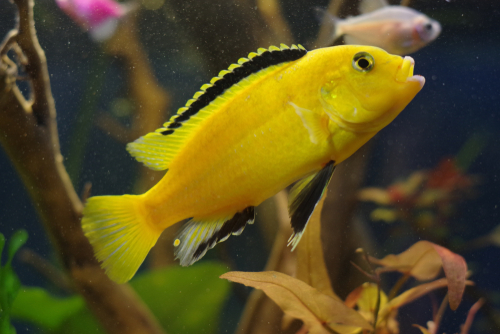
- Scientific Name: Labidochromis caeruleus
- Adult Size: 3 inches
- Compatible With: Duboisi Cichlids
- Care Level: Easy
- Origin: Lake Malawi, East Africa
The Electric Yellow Cichlid, also called the yellow lab cichlid, is member of the mbuna section of the African cichlid family. Electric yellow cichlids are beautiful with very bright yellow colors and black fins. Their bright appearance is a great contrast against the darker tones of the duboisi cichlid.
Electric Yellow cichlids are by far the most popular of the African Cichlids for aquariums. They are easy to care for as well as on the smaller side, growing to about 4 inches, so they are not as much of a resource commitment.
Pros of keeping with Duboisi Cichlid:
- No food competition
Cons of keeping with Duboisi Cichlid :
- Some chance of aggression
7. Cuckoo Catfish
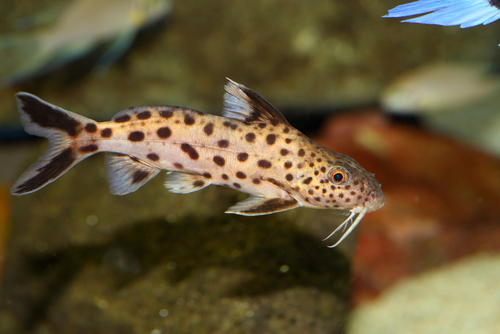
- Scientific Name: Synodontis multipunctatus
- Adult Size: 5 inches
- Compatible With: Duboisi Cichlids
- Care Level: Easy
- Origin:Lake Tanganyika
Cuckoo Catfish are fish that prefer to stay at the bottom of the tank, which means they will be well out of the way of the slightly bigger duboisi cichlid. They also have a knack for hiding very convincingly in case any other fish tries to bother them as long as you have provided them with plenty of plants, leaves, and rocks to interact with.
Cuckoo catfish, also called squeaker catfish, are happiest in groups of their own kind. They are also big fans of sand on the bottom of the tank. Cuckoo catfish are tan or brown in color. They have long fins, including a tall dorsal fin, which are usually black fringed with near-transparent white. They are covered in adorable cheetah-like spots, too.
Pros of keeping with Duboisi Cichlid:
- No aggression
- Can’t be bullied
Cons of keeping with Duboisi Cichlid :
- Must be kept with a few of it’s own kind
In Conclusion
To sum it all up, duboisi cichlid tank mates should be able to survive in the same temperature and hardness of water as the duboisi cichlid. Because the duboisi cichlid is an aggressive species, your best chance for great tank mates are African cichlids or catfish that can hold their own.
This will leave you with a tank full of fish that are not only entertaining to watch without harming one another, but beautiful to look at in their various colors and hues. Enjoy finding the perfect matches for your duboisi cichlid!

JJ has had a passion for learning about aquatic life since age 5. As an adult, he made his passion a career as a certified aquaculture dealer and aquarium content creator.


